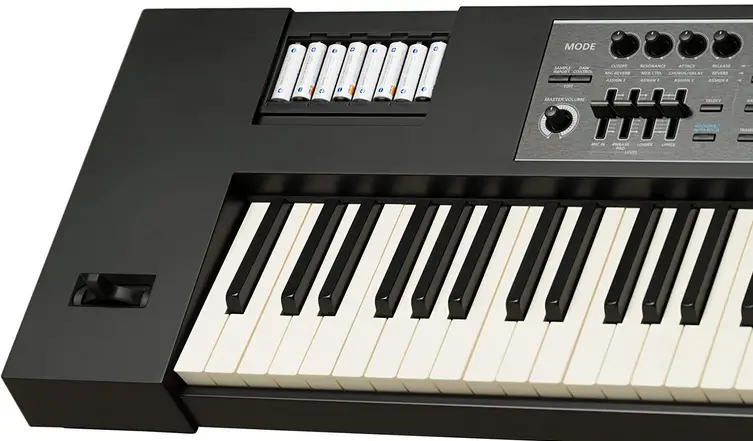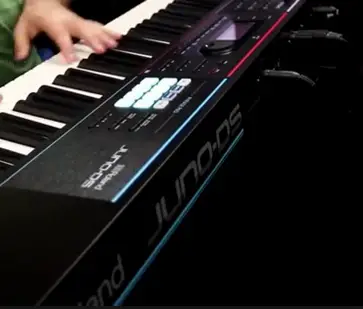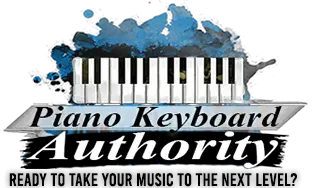 Introducing Roland’s Latest and Greatest Roland
Introducing Roland’s Latest and Greatest Roland
Are you looking for the best Roland keyboard for live performance? has been pumping out quality electronic music equipment since the 1970’s and isn’t showing any signs of slowing down. It’s no wonder why so many musicians turn to this brand when it comes to recording, performing, or even just day-to-day use. Though Roland has countless keyboards, one in particular stands out as the best for live performance: the JUNO-DS88.
The JUNO has a couple different factors in what makes it the best Roland keyboard for live performance:
- Playability
- Great sound
- Fantastic Features
Top of the Line Roland Feel
This keyboard is the first in a long line of Roland’s keyboards to hold 88 weighted action keys. The Ivory Feel-G keys with the progressive weighted hammer action make for an incredibly realistic playing experience, while still maintaining it’s lighter weight and mobility. This alone should make this keyboard irresistible to the live performer. Superbly real piano feel without a heavy keyboard? How do you beat that?
Roland Sound Options like You’d Never Believe
The Juno DS holds a massive array of sounds. With a quick touch of a button on the front display below the LCD screen, you enter into the categories of each sound, as well as their respective subsections. What does this mean for you? Well, say you’re planning out your next gig, and you want to play several songs using an electric piano voice.
Don’t quite like the sound of your electric piano? Don’t stress it, because you have literally 12 others to choose from. And that’s JUST within the electric piano subsection! You still have many more sounds to explore like classic grand pianos, organs, percussion, strings, and more!
With this keyboard, you have the opportunity to create a split sound. You can choose any sound from within your keyboard library (like I said, there are a LOT) and adjust the volume on each side as well. Something worth mentioning here is your ability to adjust where the split is!
With just one press of a button, you can select anywhere on the keyboard you’d like your first sound to end, and your second to begin. This sound can still be further customized with the ability of upper/lower volume control. If you have piano and strings layered together, you can adjust the volume of each sound independently, allowing you to create and control your own unique sound, live on set.
Getting Creative On Stage with the JUNO-DS88’s Features
If you’re STILL not satisfied with the different kinds of creative sounds you can produce with this incredible instrument, you still have eight programmable phrase pads. These phrase pads are a lot like the kinds of touch pads you’d find on MIDI controllers. Each of these pads can be assigned with sample music files imported through a USB. Previously recorded samples, vocals, effects, loops, you name it! Any and all of the above are effortlessly and quickly available to you at the press of a pad. Something also worth mentioning: each individual phrase pad has its own individual volume control.
 The JUNO series have been a great hit with players across the board with it’s instant-access design. Anybody can easily call up a variety of fantastic sounds quickly and effortlessly. But this model takes another step further, providing the player with the ability to customize and tweak sounds and performances with absolute precision. Mounted on the front panel are a wide range of knobs and sliders, allowing for detailed sound adjustment while playing live. Plus, where the JUNO falls short of editing and tweaking capabilities, you have jacks on the back panel where you can plug in expression pedals and further perfect your intended sound.
The JUNO series have been a great hit with players across the board with it’s instant-access design. Anybody can easily call up a variety of fantastic sounds quickly and effortlessly. But this model takes another step further, providing the player with the ability to customize and tweak sounds and performances with absolute precision. Mounted on the front panel are a wide range of knobs and sliders, allowing for detailed sound adjustment while playing live. Plus, where the JUNO falls short of editing and tweaking capabilities, you have jacks on the back panel where you can plug in expression pedals and further perfect your intended sound.
Another remarkable feature on this keyboard is the on-board mic input. All you need is a cable with a quarter-inch plug, and a microphone where you (or your vocalist) can sing while the piano is playing. All of these collected sounds will come out of your speakers.
This mic input comes with its own dedicated vocal reverb, and even an auto-pitch for that trendy effect you’ll often find in today’s music. Going deeper into this mic-input, the vocoder has the potential to be a lot of fun. The vocoder allows you to sing into the mic while controlling the tone and pitch based on the keys you’re playing on the keyboard.
How neat is that!? Delivering vocals at this level of quality typically requires an independent sound system and amplifiers and mixers and on and on… Not with this keyboard.
Now, if by some dark magic you’re still somehow not sold on this keyboard being the best roland keyboard for live performances, get a load of this. Beyond the assignable phrase pads, and beyond the expansive variety of keyboard voices, you can still import new sounds.
The onboard set is already very impressive, but the JUNO still allows for even more internal waveform expansion through the USB port. On just Roland’s Axial website alone, there are over 1000 downloadable sounds, voices, piano collections, world instruments, percussion, and more! Not impressed by what Roland has for download? You can still load in WAV files from your own library.
Why the JUNO DS-88 is the Best Roland Keyboard for Live Performance
Sure there are other Roland keyboards out there that are less expensive  and worthy of live performance, not to mention countless others beyond the Roland brand. But this keyboard really deserves the spotlight (both metaphorically and physically, on stage). When you factor in the portability of this musical powerhouse, combined with the weighted Ivory Feel-G keys, the impressively large range of potential sounds available to you right out of the box, the customizability with all of your knobs and sliders and phrase pads, and the ability to sync up with a mic… There really is no competition here. If you’re still unsure, click here to review the numerous 5-Star reviews on amazon, because I truly think this keyboard could be your next best friend on stage.
and worthy of live performance, not to mention countless others beyond the Roland brand. But this keyboard really deserves the spotlight (both metaphorically and physically, on stage). When you factor in the portability of this musical powerhouse, combined with the weighted Ivory Feel-G keys, the impressively large range of potential sounds available to you right out of the box, the customizability with all of your knobs and sliders and phrase pads, and the ability to sync up with a mic… There really is no competition here. If you’re still unsure, click here to review the numerous 5-Star reviews on amazon, because I truly think this keyboard could be your next best friend on stage.
